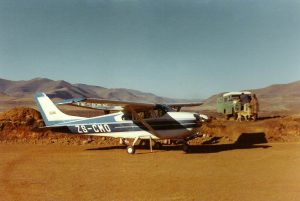
Pelaneng Airport (PEL)
You can now add favourite airports. Access them in the members area by signing up!
Pelaneng, Lesotho (LS) Small airport
IATA CodePEL
ICAO CodeFXPG
FAA Code
Latitude-29.1205997
Longitude28.5053005
Time ZoneAfrica/Maseru (GMT +2:00)
Reviews
Pelaneng Airport Reviews (1)
 World Airport Codes
World Airport Codes
I was working with Binnie & Partners on the Lesotho Highlands Water Project and was instrumental in the making of the airstrip. Read on:
But the airstrip had still to be built. And here a pair of Land-Rovers did what few have ever done: grade a runway.
Whilst it was possible to drive two bulldozers – for the airstrip, a Caterpillar D6 and a D7 – over the steep passes to Pelaneng to do the heavy work, bringing in either a conventional grader or a sheep’s foot roller (the irregular pattern type used to compact soft ground by imitating the way sheep compress soil with their pointed toes) was out of the question.
After saying, half-jokingly, “Why not use sheep’s feet?” to a table of AMICEs, I found myself rounding up close to a hundred cattle, oxen, horses, ponies, donkeys, goats – and sheep – and having them walk up and down the bulldozed headland for the best part of two days, until the ground had been compacted evenly over the whole length and width of the 2,160 foot long runway area.
Next came the question of how to smooth out the myriad of pockmarks left by the scores of tramping animals. My first idea – of using sixteen oxen hooked to a lorry’s flat load bed that, for reasons unknown, had been left on the headland – came to nought; they were just not used to working in unison as a single full team. They usually worked in pairs – pulling a cart, or a plough, or threshing corn by walking over it, round and round in circles – and that was all.
I looked at the faithful sons of Solihull. We attached one Land-Rover by chains to the lorry bed – with its upper smooth side now facing the ground – but at an angle like a grader blade, and started off. The single station wagon was straining a bit at the amount of drag, so we hooked the second one on in tandem.
It worked like a charm. The two vehicles went up and down until all the bumps and roughness were gone.
Another job for the Land-Rovers was removing great lumps of bedrock too massive to be dug up by the bulldozers. Left where they were, they would have been a potential hazard to aircraft. We dowsed the bedrock with petrol or diesel and set it alight. With the rock well heated, we chilled it with cold water. Chunks broke off, and were loaded onto the lorry load bed to be driven away. One big boulder did not break apart and needed towing or rolling away. As with the improvised grader, one Land-Rover was not enough, so, with two chained again in tandem, the task was completed – leaving Pelaneng Airport (IATA code PEL) at 7,200 feet altitude ready for its first arrival. George Hallowes – the engineer I worked with for most of my time with Binnie’s – flew in on the first plane. Shortly afterwards, on 12th June 1971, I went in and out on a Cessna 210.